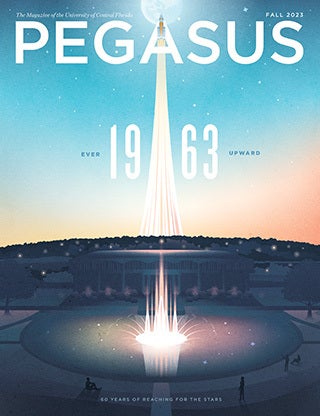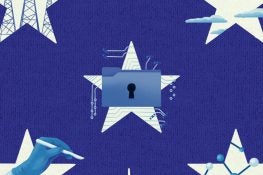Whether it’s solving the world’s biggest problems or investigating the potential of novel discoveries, researchers at UCF are on the edge scientific breakthroughs that aim to make an impact. Through the , student and faculty researchers condense their complex studies into bite-sized summaries so you can know how and why Knights plan to improve our world.
Name: Tara Pattilachan ’22
Major: Biomedical sciences
Why are you interested in this research?
My fascination with this research emerged from its position at the pinnacle of contemporary medicine, combining materials science and engineering principles to develop personalized gene delivery methods. Amid the COVID-19 pandemic, I dove into initiatives like developing a contact tracer app and a COVID-19 public policy map in collaboration with Hikma Health — all from my own space at home. However, it was during my time as a journalism fellow at StartUp Health, interviewing leaders in pharmaceuticals and biotechnology companies, that I truly understood the central role of gene therapy and nanomedicine in producing and distributing COVID-19 vaccines globally. Inspired to be part of this monumental effort, I found an avenue at Dr. Mehdi Razavi’s Biomaterials and Nanomedicine Lab at the UCF College of Medicine. There, we’re advancing the field by targeting osteoporosis treatment through personalized, ‘theranostic’ (therapeutic and diagnostic) nanobubbles. In parallel, my experiences as a medical assistant and in clinical settings allowed me to meet osteoporosis patients, whose personal stories, challenges, and hopes of a cure cemented my commitment to research in gene therapy and nanomedicine.
How did you get started in research at UCF?
Upon arriving at UCF, I was already set on a research-driven path, informed by experiences few students have had. In high school, my participation in the National Brain Bee offered a glimpse into the potential of neuroscience research, which was further solidified by a brief role working in Alzheimer’s research at USF. At UCF, my initial interest gravitated towards computational studies, leading me to Dr. Ulas Bagci’s Medical Imaging Lab, then a part of UCF’s Center of Research in Computer Vision and now situated at Northwestern’s Feinberg School of Medicine. This lab exposed me to cutting-edge artificial intelligence applications in medical research, where I honed my skills in ‘dry’ lab techniques and programming. However, as I advanced in my undergraduate studies, my focus shifted to gene therapy, particularly its applications in cancer treatment. This newfound interest directed me to Dr. Razavi’s lab, laying the groundwork for my honors thesis. Transitioning from the vastness of artificial intelligence to the minute realm of nanomedicine, I’ve come to learn that sometimes the tiniest particles wield the greatest influence over human health.
Who is your mentor? Who inspires you and how?
Pinpointing a singular mentor or source of inspiration feels almost impossible, as my journey has been shaped by a mosaic of influential individuals. Dr. Bagci and Dr. Razavi, for instance, have played (and continue to play) pivotal mentorship roles in my professional trajectory, fueling my interest in joining computational and engineering principles with clinical medicine. My family, teachers, and friends form the foundation of my personal values, giving me the strength and motivation to tackle challenges head-on. My admiration also extends to my current supervisor and mentor, Dr. Sharona Ross, who is an exceptional surgeon devoted to robotic surgery research and championing women in surgery. However, I firmly believe that every interaction I’ve had has taught me something valuable and served as a source of inspiration in its own unique way.
How does UCF empower you to do your research?
UCF has been integral to my research journey and has been a major catalyst for my growth. Given its vast size and scale, the university provides a wide and niche array of research opportunities for its students. What sets UCF apart from other institutions is its proactive approach in motivating students to engage in research. Through initiatives like student research grants and the Student Undergraduate Research Council to summer fellowships and presenting at the Student Scholar Symposium, UCF’s commitment is clear: this is an institution dedicated to fostering the next generation of leaders and innovators. Every faculty member I’ve interacted with through my years has shown genuine support for students, valuing their curiosity over their background or prior experience.
With UCF’s support, I presented my work at the College of Medicine’s Biionix Symposium, a milestone that immensely promoted my confidence in effectively conveying research concepts to audiences. I’m also looking forward to presenting my research at another conference later this year. In addition, I’ve had the privilege to collaborate on a literature review on nanobubbles alongside other fellow UCF students — a clear testament to the collaborative culture here. UCF’s emphasis on innovation and entrepreneurship has also allowed me to file a patent related to my honors undergraduate thesis, introducing a novel method for synthesizing nanobubbles targeting osteoporosis. My journey hasn’t been without its hurdles, but UCF has consistently been a source of encouragement and opportunity. Grateful for the knowledge and experiences I’ve attained, I’m now focused on mentoring the next generation of UCF students, guiding them through the multifaceted world of research and the limitless opportunities here.
Why is this research important?
Osteoporosis, a debilitating disease that affects millions of people worldwide, currently lacks a definitive cure. The existing treatments, such as bisphosphonates and anabolic therapies, come with their own set of complications, including atypical fractures and osteonecrosis in the jaw. It’s clear that a novel breakthrough is needed.
Enter nanobubbles: our innovative, non-invasive solution. As the scientific community buzzes about the applications of gene editing and delivery, nanobubbles have emerged as a promising gene delivery vehicle candidate. These small echogenic gas cores can load, expand, and subsequently release therapeutic drugs or genes. Their novelty lies in their dual functionality: not only can they deliver cathepsin K siRNA to disrupt osteoclasts, which are responsible for bone degradation, but they are also ultrasound-responsive, serving as contrast agents in ultrasound imaging. This synergistic approach is complemented by the therapeutic potential of low-intensity ultrasound pulses, which can promote bone and tissue regeneration.
However, the significance of this research extends beyond laboratory experiments and academic discussions. I recently lectured at the University of South Florida’s Osher Lifelong Learning Institute, where I introduced senior citizens to the field of gene therapy. After sharing some insights from my thesis, many approached me with their personal struggles with illnesses like cancer and osteoporosis. Their stories, full of optimism and anticipation, illustrated the real-world implications of our work.
Looking to the horizon, as we venture into the era of space exploration and tourism, the health challenges posed by microgravity-induced strain and ionizing radiation cannot be ignored. Osteoporosis and bone fractures intensified in the space environment will pose a significant challenge, even to the young. Our work with nanobubbles could very well be the ultimate countermeasure, ensuring that as we embark on interstellar journeys, we remain strong against the health challenges of the cosmos.




